SEO
How to Define & Track 7 Key Goals

Online marketing blog, Backlinko.com recently sold to SEMRush for an undisclosed amount.
But we can safely assume it wasn’t cheap.
Between 2013 and 2018, over 4,000 people signed up for the Backlinko.com training program, “SEO that works.”
At $5,964 per subscription, that’s over $23,856,000 in sales.
To join the rank of top B2B publishers like Backlinko, with 468k YouTube subscribers and over 500,000 organic monthly visitors, you can’t wing it.
You need to set detailed content marketing goals.
We’ve got you covered. In this guide, you’ll learn how to define and measure seven essential content marketing goals for B2B publishers:
- Lead Generation.
- Brand Awareness.
- Thought Leadership.
- Organic Share of Voice.
- Roadblocks.
- Educate and Inform.
- User Engagement.
1. Lead Generation
Let’s start with the most important goal, which is tied to money going into your bank account: lead generation.
New prospects may come through whitepaper or ebook downloads, form submissions, or demo calls.
I think we can all agree on why content that engages new prospects is important. You have to keep feeding the machine.
Without new prospects, business stalls or declines.
Determining what type of content supports lead generation can get a little complicated. But stay with me.
Essentially, you need to work backward from your best prospects to find your “high-value pages.”
Defining Lead Gen Goals
This process will not work unless Google Analytics is properly configured with goals in direct relation to how they support your business objectives (and even better if values have been assigned by goal completion type).
The first step is finding what content assists in a user completing one of those predefined goals.
Then make an assessment, is there a trend in the type of content?
Why did this content resonate with your audience?
The answers to these questions will inform your content marketing strategy to get new prospects.
Lastly, work out how many more pages you need to hit your sales goal.
This number is based on the proposed new traffic volume and historical conversion rate.
Measuring Lead Gen
Measuring whether content meets the lead generation goals is easy using Google Analytics.
Here’s how to measure an increase in new prospects:
- Open Google Analytics.
- Click Conversions and Goals.
- Select the Overview report.
- Set Date to the observed time period.
- Set Goals to source/medium.
- View number of goal completions for organic by goal type.
Pro-tip: Take measurement a step further and connect with the sales lead to measure the lift in lead to closed contract.
2. Increase Brand Awareness
Brand awareness is embedding itself into consumer lifestyles and habits (workflows) so that they don’t have to think twice before asking for a Kleenex (facial tissue.)
To do this successfully, a brand must establish trust and consistently create positive associations.
Defining Brand Awareness Goals
There are various types of content that support brand awareness.
You’ll want to select one that is sustainable long-term for a public face of the brand (think CEO or CMO).
Here are a few different types of content to consider.
Storytelling
Authenticity has a powerful influence on public opinion, and it can lead to a big boost in brand awareness.
Beyond the company motto, what is the purpose of your business?
How did it come to be?
Crafting a narrative around your brand humanizes it and gives something real for people to connect with.
Guest blogging
Where else do your users spend time?
You can leverage these sites to get more eyes on your brand.
Keep in mind, the purpose is not to push your company but to offer actually helpful content.
Podcasts
Bring your content to life and connect directly with your audience.
I’m sure you’re picking up on the content trend for brand awareness: authenticity.
A podcast is not to bluntly pitch your company.
It’s an opportunity to educate, entertain and grab the ear of your audience in a way that isn’t possible in print.
Measuring Brand Awareness
 Screenshot from Google Search Console, January 2022
Screenshot from Google Search Console, January 2022Measuring the success of a brand awareness campaign is a little vague.
All the offline conversations between colleagues, feelings of trust, and positive associations are not captured in Google Analytics.
But, we can measure whether content increases brand awareness with intent (as it relates to brand name Google Search volume.)
Here’s how to segment users that already know your brand:
- Open Google Search Console.
- Set Date to the observed time period (12 months).
- Click New and select Query.
- Click the filter drop-down menu (queries containing).
- Select Custom (regex) and Matches regex.
- Use regex that specifies multiple variants of your company name, including misspellings.
3. Thought Leadership
Trust and credibility are two words that constantly come up in conversations about content marketing goals for B2B publishers.
A great way to build credibility with your audience is by creating thought leadership content.
You can do this by sharing unique perspectives, experiences, or resources.
Defining Thought Leadership Goals
The best way to create thought-leading content is by understanding your audience and conveying insights they find valuable.
If you have access to proprietary data, mine that for unique insights and share them with your industry in a deep dive case study and bite-sized graphics.
Or, if you have built a network of professional connections, share their insights that can be conveyed to the masses!
Measuring Thought Leadership
 Screenshot from Google Search Console, January 2022
Screenshot from Google Search Console, January 2022Think of what it means to lead; a good leader has a growing base of users who are excited about the content.
Whether that content is shared through an eNewsletter, YouTube channel, podcast, or social media group you will be able to track subscribers, opens/views, and shares.
Subscriber data should be available within your platform of choice.
For organic channel metrics, look at the search console backlinks report.
Are people linking to your article as a good source of reference?
Here’s how to see which pages on your site have backlinks using Google Search Console:
- Open Google Search Console.
- Under legacy tools and reports select Links.
- Under Top linked pages click More.
Pro-tip: From the search console “top linked pages – externally” report you will have a sheet with every target page, number of incoming links, and number of linking sites.
Review this content to find a trend in the type of articles your audience is interested in seeing more of.
4. Improving Organic Share Of Voice
Identifying your competitors’ strengths and weaknesses is key to setting your brand apart.
One way to “crush the competition” is to improve organic share of voice.
Organic share of voice is a measurement of how visible your site is in organic search, for a set of keywords, compared to your top competitors.
A quick way to get more SERP visibility and clicks is by winning featured snippets.
Featured snippets are pieces of information that display at the top of search results for a search query.
Defining Organic SOV Goals
To find your best-featured snippets opportunities, use your rank tracker of choice and filter to keywords that you rank in positions 2 – 5 for those that have featured snippets.
The most popular keywords should be at the top of your list.
Sort them by traffic volume, from greatest to lowest.
Use this data to find out how well you are doing in terms of visibility on key topics for your business.
If you find any gaps, then you will need to do more competitive research.
Measuring Organic Share Of Voice
 Screenshot from Ahrefs, January 2022
Screenshot from Ahrefs, January 2022Calculating organic share of voice is not straightforward but is possible using tools that compare your search visibility for your target keywords to that of your competitors.
Here’s how to do it using Ahrefs Rank Tracker:
- Open Ahrefs Rank Tracker.
- Paste a list of your main keywords.
- Add your competitors’ domains.
- Click the Competitors report in the overview tab.
- View the visibility metric to see your organic share of voice.
Pro-tip: Do this at the beginning of your content marketing campaign to improve organic SOV and see how your visibility metric improves over time.
5. Reducing Roadblocks
During content strategy sessions, consider why users did not choose your company.
Addressing the reasons why prospects are saying no, enables your company to either highlight that your company does provide the product/service they were looking for – or why the product/service you provide is better than what they think they need.
Defining Organic Share Of Voice Goals
You’ll need to work closely with your sales team.
Team members will need to be notating why people say no.
Or, send a simple survey to lost prospects.
Measuring Reduction In Roadblocks
Measuring whether or not content is intended to reduce roadblocks is easy enough.
Keep in close contact with the sales team.
Is there a reduction in roadblocks, is there an improvement in time to closing or cost of closing?
6. Educational/Informational
Educational or informational content is my personal favorite for B2B publishers because it checks off many of the content marketing goals: Reduce roadblocks, establish trust and credibility and increase new prospects.
I’m a firm believer that people don’t like to be sold to and by sharing knowledge you grow a network of people who value your insights.
So when that topic comes up – they think of you, they share your contact information, they trust your insights.
When a brand provides quality informational content they connect with their audience in an authentic, memorable way.
Defining Educational Goals
Defining educational goals is going to differ depending on the medium through which you’re comfortable sharing information.
You definitely do not need to invest in creating a whole new channel – use the features within the channel that are already working for you.
Because I’m a search engine marketer, I’m going to share an example using Google organic as the medium.
Here’s how to analyze content that is bringing users that indicated they began with a question:
- Open Google Search Console.
- Under Performance select Search results.
- Set Date to the observed time period.
- Click New and select Query.
- Click the filter drop-down menu (queries containing)
- Select Custom (regex) and Matches regex.
- Use regex to show results that indicate a question: what|how|when|why.
Measuring Informational Content
 Screenshot from Google Search Console, January 2022
Screenshot from Google Search Console, January 2022Measuring the success of informational content is a bit fuzzy because education is not necessarily a linear process.
Users view information based on what they’re doing at the time and what they want to read, not how you draw it out in storyboards.
Consider a few metrics: page rank and traffic volume for the queries that indicate a question.
In order for an educational article to be helpful, your audience has to know about it, hence page rank and traffic volume.
If users like it, they are likely to engage with the content and return for more.
More on increasing user engagement in the next section.
7. Increase User Engagement
Step into your audience’s shoes.
There is so much content out there, it can be tough to get their attention.
You have to make sure that the content you are producing is the content that they want to read and that it delivers consistently.
Users who spend time reading your content are telling your team something really important.
They are saying that they value this content and that it is worthy of their time.
Defining User Engagement Goals
Users who engage with your content are more likely to recommend your brand to others, renew their subscription or upgrade.
To define user engagement goals you need to find your top-performing pages for this metric and analyze why.
Measuring User Engagement
User engagement is best measured using Google Analytics 4.
 Screenshot from Google Analytics 4, January 2022
Screenshot from Google Analytics 4, January 2022Here’s how to analyze content that your users engage with the most:
- Open GA4.
- Under Engagement Pages and screens report.
- Set Date to the observed time period.
- Filter to organic users.
- View the table by unique user scrolls.
Note: Unique user scrolls, average engagement time, or a specific event depending on what metric you use to measure engagement.
Final Thoughts
B2B consumers are tech-savvy.
They’re checking multiple pieces of content across several sites and cross-referencing with friends, colleagues and within professional networking groups.
Don’t fall into the trap of a “slick trick” that oversimplifies content marketing.
When done correctly, the content will position your company to answer their questions, nurture their opinion of you, and ultimately convert them into loyal followers/customers.
More resources:
Featured Image: Alphavector/Shutterstock
SEO
How To Write ChatGPT Prompts To Get The Best Results

ChatGPT is a game changer in the field of SEO. This powerful language model can generate human-like content, making it an invaluable tool for SEO professionals.
However, the prompts you provide largely determine the quality of the output.
To unlock the full potential of ChatGPT and create content that resonates with your audience and search engines, writing effective prompts is crucial.
In this comprehensive guide, we’ll explore the art of writing prompts for ChatGPT, covering everything from basic techniques to advanced strategies for layering prompts and generating high-quality, SEO-friendly content.
Writing Prompts For ChatGPT
What Is A ChatGPT Prompt?
A ChatGPT prompt is an instruction or discussion topic a user provides for the ChatGPT AI model to respond to.
The prompt can be a question, statement, or any other stimulus to spark creativity, reflection, or engagement.
Users can use the prompt to generate ideas, share their thoughts, or start a conversation.
ChatGPT prompts are designed to be open-ended and can be customized based on the user’s preferences and interests.
How To Write Prompts For ChatGPT
Start by giving ChatGPT a writing prompt, such as, “Write a short story about a person who discovers they have a superpower.”
ChatGPT will then generate a response based on your prompt. Depending on the prompt’s complexity and the level of detail you requested, the answer may be a few sentences or several paragraphs long.
Use the ChatGPT-generated response as a starting point for your writing. You can take the ideas and concepts presented in the answer and expand upon them, adding your own unique spin to the story.
If you want to generate additional ideas, try asking ChatGPT follow-up questions related to your original prompt.
For example, you could ask, “What challenges might the person face in exploring their newfound superpower?” Or, “How might the person’s relationships with others be affected by their superpower?”
Remember that ChatGPT’s answers are generated by artificial intelligence and may not always be perfect or exactly what you want.
However, they can still be a great source of inspiration and help you start writing.
Must-Have GPTs Assistant
I recommend installing the WebBrowser Assistant created by the OpenAI Team. This tool allows you to add relevant Bing results to your ChatGPT prompts.
This assistant adds the first web results to your ChatGPT prompts for more accurate and up-to-date conversations.
It is very easy to install in only two clicks. (Click on Start Chat.)
For example, if I ask, “Who is Vincent Terrasi?,” ChatGPT has no answer.
With WebBrower Assistant, the assistant creates a new prompt with the first Bing results, and now ChatGPT knows who Vincent Terrasi is.
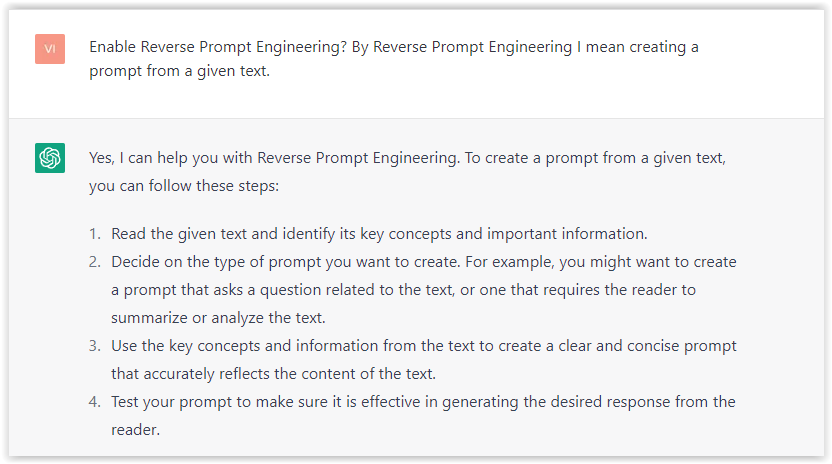 Screenshot from ChatGPT, March 2023
Screenshot from ChatGPT, March 2023You can test other GPT assistants available in the GPTs search engine if you want to use Google results.
Master Reverse Prompt Engineering
ChatGPT can be an excellent tool for reverse engineering prompts because it generates natural and engaging responses to any given input.
By analyzing the prompts generated by ChatGPT, it is possible to gain insight into the model’s underlying thought processes and decision-making strategies.
One key benefit of using ChatGPT to reverse engineer prompts is that the model is highly transparent in its decision-making.
This means that the reasoning and logic behind each response can be traced, making it easier to understand how the model arrives at its conclusions.
Once you’ve done this a few times for different types of content, you’ll gain insight into crafting more effective prompts.
Prepare Your ChatGPT For Generating Prompts
First, activate the reverse prompt engineering.
- Type the following prompt: “Enable Reverse Prompt Engineering? By Reverse Prompt Engineering I mean creating a prompt from a given text.”
 Screenshot from ChatGPT, March 2023
Screenshot from ChatGPT, March 2023ChatGPT is now ready to generate your prompt. You can test the product description in a new chatbot session and evaluate the generated prompt.
- Type: “Create a very technical reverse prompt engineering template for a product description about iPhone 11.”
 Screenshot from ChatGPT, March 2023
Screenshot from ChatGPT, March 2023The result is amazing. You can test with a full text that you want to reproduce. Here is an example of a prompt for selling a Kindle on Amazon.
- Type: “Reverse Prompt engineer the following {product), capture the writing style and the length of the text :
product =”
 Screenshot from ChatGPT, March 2023
Screenshot from ChatGPT, March 2023I tested it on an SEJ blog post. Enjoy the analysis – it is excellent.
- Type: “Reverse Prompt engineer the following {text}, capture the tone and writing style of the {text} to include in the prompt :
text = all text coming from https://www.searchenginejournal.com/google-bard-training-data/478941/”
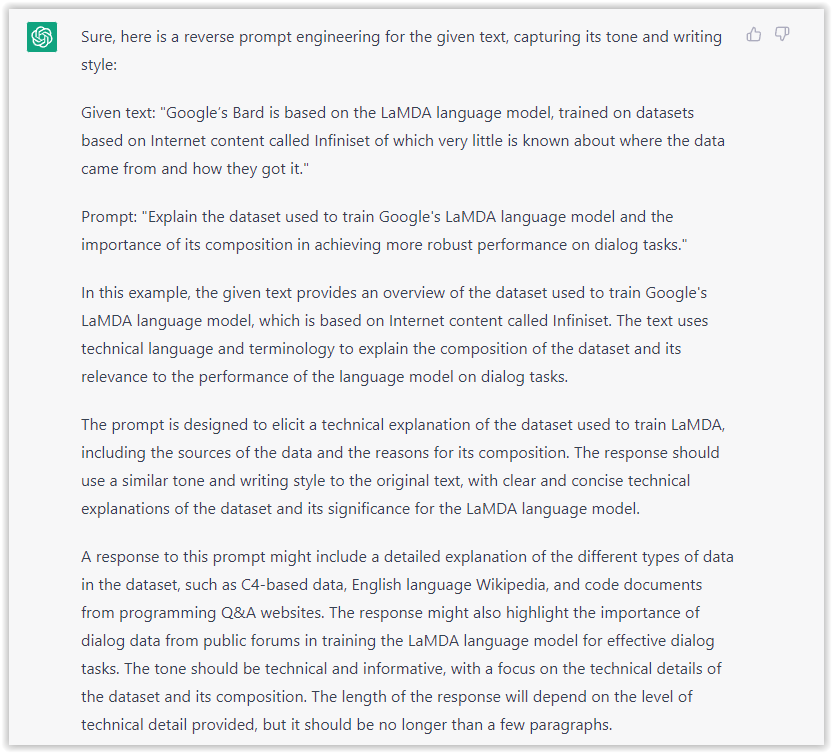 Screenshot from ChatGPT, March 2023
Screenshot from ChatGPT, March 2023But be careful not to use ChatGPT to generate your texts. It is just a personal assistant.
Go Deeper
Prompts and examples for SEO:
- Keyword research and content ideas prompt: “Provide a list of 20 long-tail keyword ideas related to ‘local SEO strategies’ along with brief content topic descriptions for each keyword.”
- Optimizing content for featured snippets prompt: “Write a 40-50 word paragraph optimized for the query ‘what is the featured snippet in Google search’ that could potentially earn the featured snippet.”
- Creating meta descriptions prompt: “Draft a compelling meta description for the following blog post title: ’10 Technical SEO Factors You Can’t Ignore in 2024′.”
Important Considerations:
- Always Fact-Check: While ChatGPT can be a helpful tool, it’s crucial to remember that it may generate inaccurate or fabricated information. Always verify any facts, statistics, or quotes generated by ChatGPT before incorporating them into your content.
- Maintain Control and Creativity: Use ChatGPT as a tool to assist your writing, not replace it. Don’t rely on it to do your thinking or create content from scratch. Your unique perspective and creativity are essential for producing high-quality, engaging content.
- Iteration is Key: Refine and revise the outputs generated by ChatGPT to ensure they align with your voice, style, and intended message.
Additional Prompts for Rewording and SEO:
– Rewrite this sentence to be more concise and impactful.
– Suggest alternative phrasing for this section to improve clarity.
– Identify opportunities to incorporate relevant internal and external links.
– Analyze the keyword density and suggest improvements for better SEO.
Remember, while ChatGPT can be a valuable tool, it’s essential to use it responsibly and maintain control over your content creation process.
Experiment And Refine Your Prompting Techniques
Writing effective prompts for ChatGPT is an essential skill for any SEO professional who wants to harness the power of AI-generated content.
Hopefully, the insights and examples shared in this article can inspire you and help guide you to crafting stronger prompts that yield high-quality content.
Remember to experiment with layering prompts, iterating on the output, and continually refining your prompting techniques.
This will help you stay ahead of the curve in the ever-changing world of SEO.
More resources:
Featured Image: Tapati Rinchumrus/Shutterstock
SEO
Measuring Content Impact Across The Customer Journey
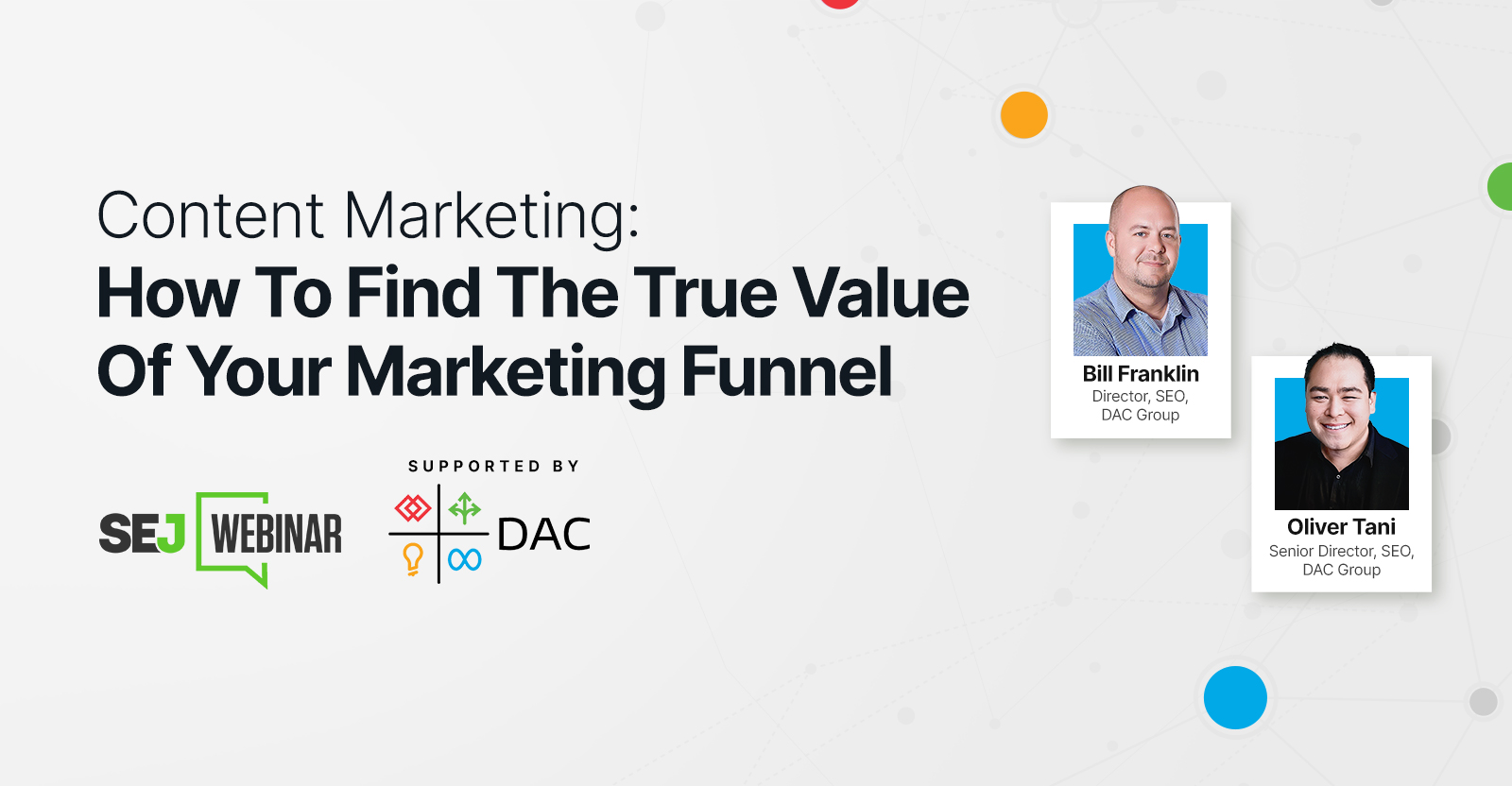
Understanding the impact of your content at every touchpoint of the customer journey is essential – but that’s easier said than done. From attracting potential leads to nurturing them into loyal customers, there are many touchpoints to look into.
So how do you identify and take advantage of these opportunities for growth?
Watch this on-demand webinar and learn a comprehensive approach for measuring the value of your content initiatives, so you can optimize resource allocation for maximum impact.
You’ll learn:
- Fresh methods for measuring your content’s impact.
- Fascinating insights using first-touch attribution, and how it differs from the usual last-touch perspective.
- Ways to persuade decision-makers to invest in more content by showcasing its value convincingly.
With Bill Franklin and Oliver Tani of DAC Group, we unravel the nuances of attribution modeling, emphasizing the significance of layering first-touch and last-touch attribution within your measurement strategy.
Check out these insights to help you craft compelling content tailored to each stage, using an approach rooted in first-hand experience to ensure your content resonates.
Whether you’re a seasoned marketer or new to content measurement, this webinar promises valuable insights and actionable tactics to elevate your SEO game and optimize your content initiatives for success.
View the slides below or check out the full webinar for all the details.
SEO
How to Find and Use Competitor Keywords

Competitor keywords are the keywords your rivals rank for in Google’s search results. They may rank organically or pay for Google Ads to rank in the paid results.
Knowing your competitors’ keywords is the easiest form of keyword research. If your competitors rank for or target particular keywords, it might be worth it for you to target them, too.
There is no way to see your competitors’ keywords without a tool like Ahrefs, which has a database of keywords and the sites that rank for them. As far as we know, Ahrefs has the biggest database of these keywords.
How to find all the keywords your competitor ranks for
- Go to Ahrefs’ Site Explorer
- Enter your competitor’s domain
- Go to the Organic keywords report
The report is sorted by traffic to show you the keywords sending your competitor the most visits. For example, Mailchimp gets most of its organic traffic from the keyword “mailchimp.”


Since you’re unlikely to rank for your competitor’s brand, you might want to exclude branded keywords from the report. You can do this by adding a Keyword > Doesn’t contain filter. In this example, we’ll filter out keywords containing “mailchimp” or any potential misspellings:
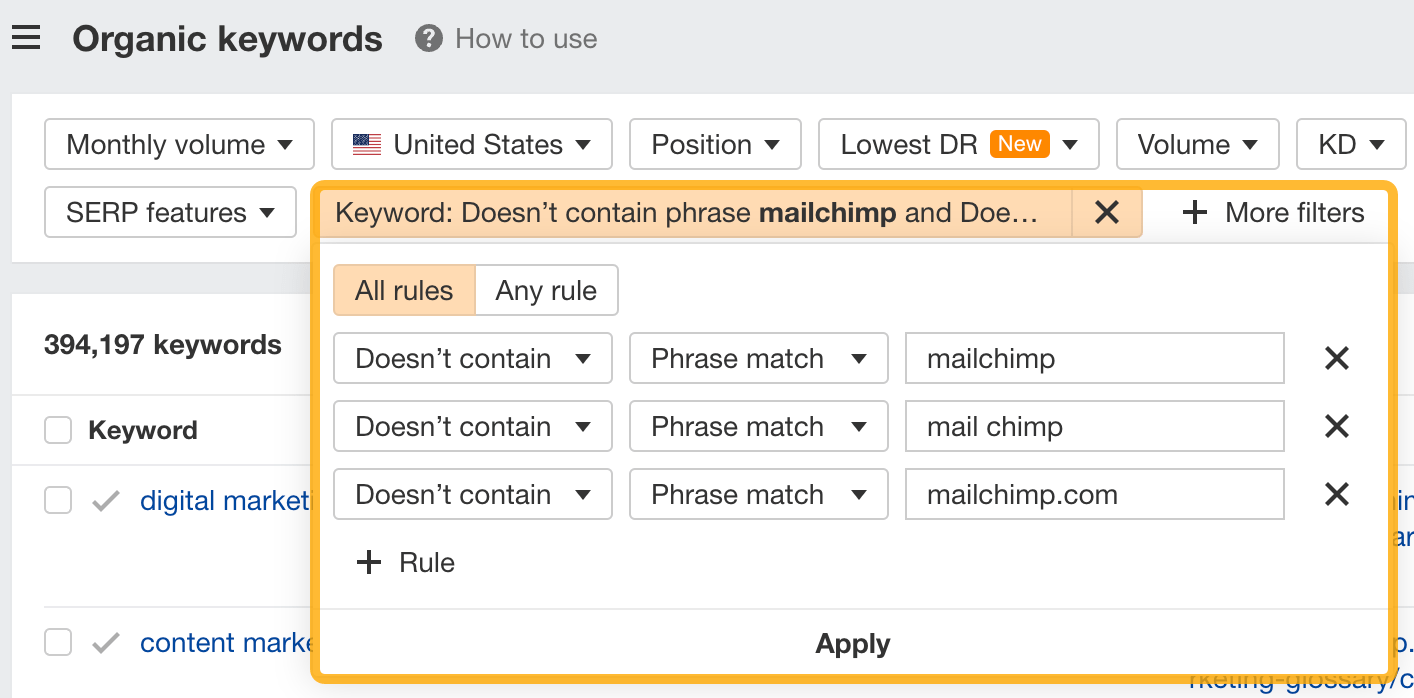

If you’re a new brand competing with one that’s established, you might also want to look for popular low-difficulty keywords. You can do this by setting the Volume filter to a minimum of 500 and the KD filter to a maximum of 10.


How to find keywords your competitor ranks for, but you don’t
- Go to Competitive Analysis
- Enter your domain in the This target doesn’t rank for section
- Enter your competitor’s domain in the But these competitors do section


Hit “Show keyword opportunities,” and you’ll see all the keywords your competitor ranks for, but you don’t.


You can also add a Volume and KD filter to find popular, low-difficulty keywords in this report.


How to find keywords multiple competitors rank for, but you don’t
- Go to Competitive Analysis
- Enter your domain in the This target doesn’t rank for section
- Enter the domains of multiple competitors in the But these competitors do section
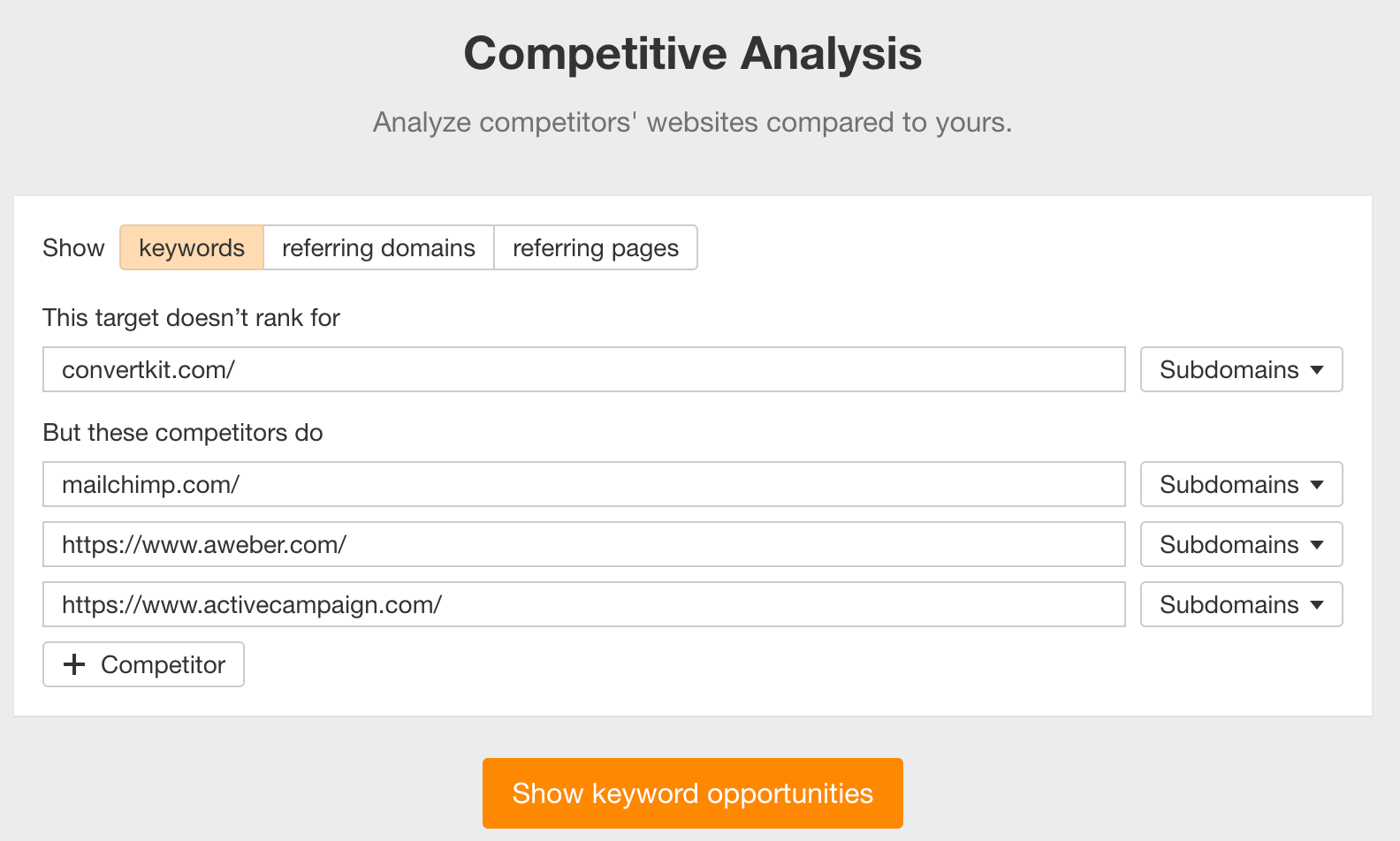

You’ll see all the keywords that at least one of these competitors ranks for, but you don’t.


You can also narrow the list down to keywords that all competitors rank for. Click on the Competitors’ positions filter and choose All 3 competitors:


- Go to Ahrefs’ Site Explorer
- Enter your competitor’s domain
- Go to the Paid keywords report
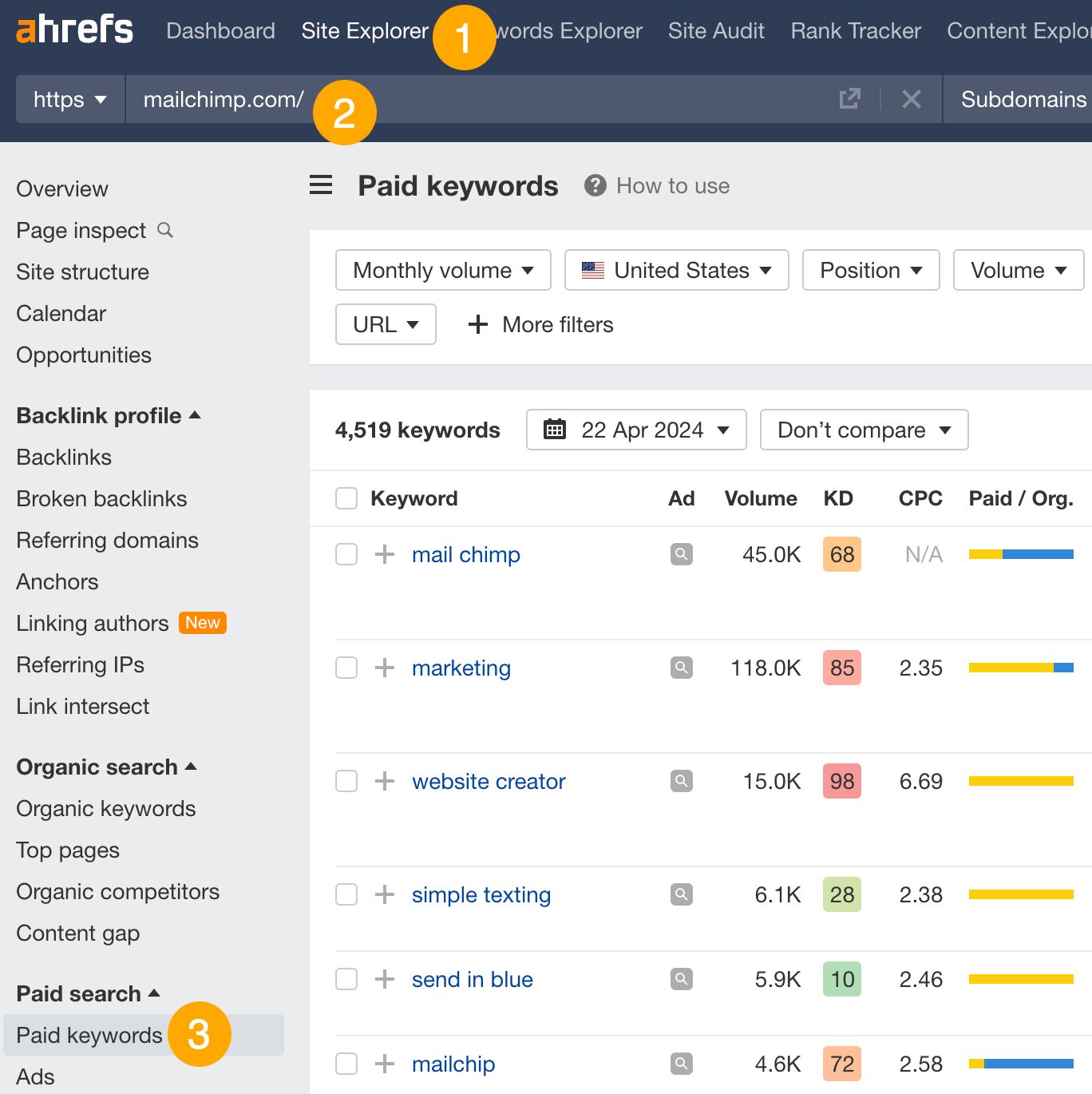

This report shows you the keywords your competitors are targeting via Google Ads.
Since your competitor is paying for traffic from these keywords, it may indicate that they’re profitable for them—and could be for you, too.
You know what keywords your competitors are ranking for or bidding on. But what do you do with them? There are basically three options.
1. Create pages to target these keywords
You can only rank for keywords if you have content about them. So, the most straightforward thing you can do for competitors’ keywords you want to rank for is to create pages to target them.
However, before you do this, it’s worth clustering your competitor’s keywords by Parent Topic. This will group keywords that mean the same or similar things so you can target them all with one page.
Here’s how to do that:
- Export your competitor’s keywords, either from the Organic Keywords or Content Gap report
- Paste them into Keywords Explorer
- Click the “Clusters by Parent Topic” tab


For example, MailChimp ranks for keywords like “what is digital marketing” and “digital marketing definition.” These and many others get clustered under the Parent Topic of “digital marketing” because people searching for them are all looking for the same thing: a definition of digital marketing. You only need to create one page to potentially rank for all these keywords.
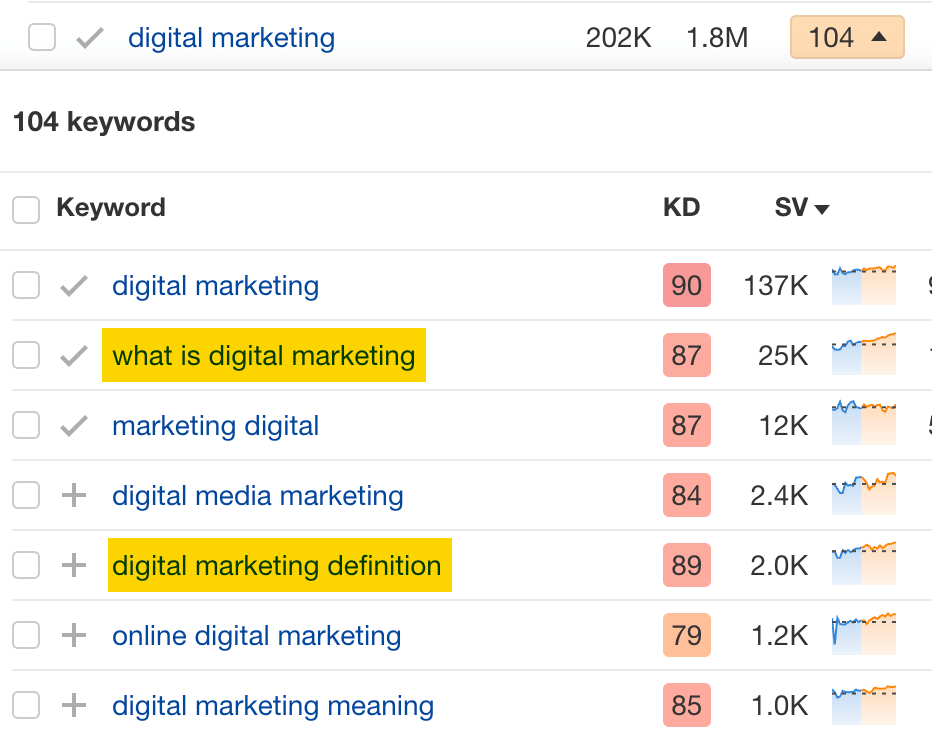

2. Optimize existing content by filling subtopics
You don’t always need to create new content to rank for competitors’ keywords. Sometimes, you can optimize the content you already have to rank for them.
How do you know which keywords you can do this for? Try this:
- Export your competitor’s keywords
- Paste them into Keywords Explorer
- Click the “Clusters by Parent Topic” tab
- Look for Parent Topics you already have content about
For example, if we analyze our competitor, we can see that seven keywords they rank for fall under the Parent Topic of “press release template.”


If we search our site, we see that we already have a page about this topic.


If we click the caret and check the keywords in the cluster, we see keywords like “press release example” and “press release format.”
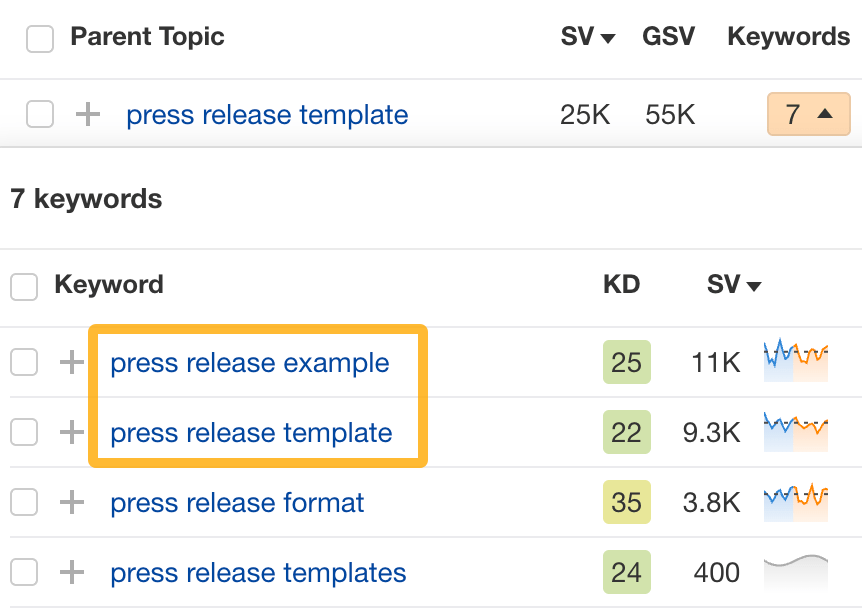

To rank for the keywords in the cluster, we can probably optimize the page we already have by adding sections about the subtopics of “press release examples” and “press release format.”
3. Target these keywords with Google Ads
Paid keywords are the simplest—look through the report and see if there are any relevant keywords you might want to target, too.
For example, Mailchimp is bidding for the keyword “how to create a newsletter.”


If you’re ConvertKit, you may also want to target this keyword since it’s relevant.
If you decide to target the same keyword via Google Ads, you can hover over the magnifying glass to see the ads your competitor is using.
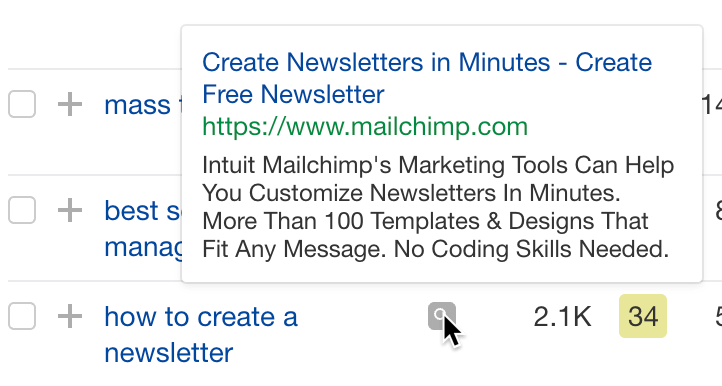

You can also see the landing page your competitor directs ad traffic to under the URL column.


Learn more
Check out more tutorials on how to do competitor keyword analysis:
-

 PPC6 days ago
PPC6 days ago19 Best SEO Tools in 2024 (For Every Use Case)
-
SEARCHENGINES7 days ago
Daily Search Forum Recap: April 17, 2024
-
SEARCHENGINES6 days ago
Daily Search Forum Recap: April 18, 2024
-
SEARCHENGINES5 days ago
Daily Search Forum Recap: April 19, 2024
-

 MARKETING6 days ago
MARKETING6 days agoEcommerce evolution: Blurring the lines between B2B and B2C
-

 WORDPRESS5 days ago
WORDPRESS5 days agoHow to Make $5000 of Passive Income Every Month in WordPress
-

 SEO6 days ago
SEO6 days ago2024 WordPress Vulnerability Report Shows Errors Sites Keep Making
-

 WORDPRESS6 days ago
WORDPRESS6 days ago10 Amazing WordPress Design Resouces – WordPress.com News















You must be logged in to post a comment Login